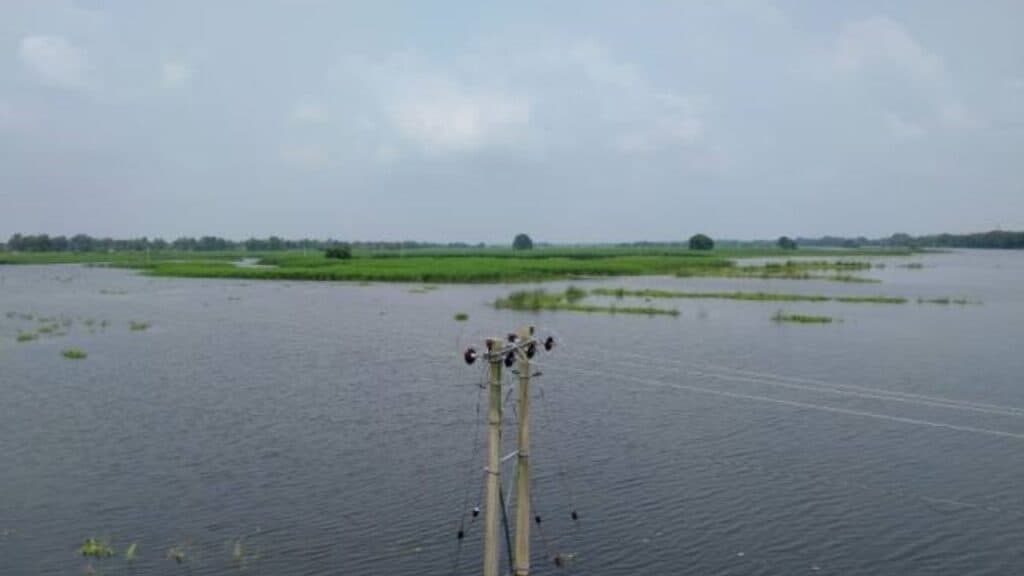New Delhi (Agency): Widespread flooding due to the overflowing Yamuna river has further ravaged farm land in Karnal district. However, Wednesday saw a decrease in the water level at Haryana’s Hathnikund barrage, reducing the water discharged from the barrage from around 3.21 lakh cusecs on Tuesday to 1.36 lakh cusecs.
Torrential rains have wreaked havoc in the Indian states of Punjab and Haryana, leading to the displacement of approximately 10,000 people from inundated areas over the past three days, according to authorities. As the focus intensifies on relief efforts, the death toll due to these rain-induced calamities has tragically reached 18, with Punjab accounting for 11 fatalities and Haryana for seven.
The districts hit hardest in Punjab include Patiala, Rupnagar, Moga, Ludhiana, Mohali, SBS Nagar, and Fatehgarh Sahib, from where residents have been evacuated due to extensive waterlogging. Adjacent Haryana also grapples with widespread flooding, with Chief Minister Manohal Lal Khattar expected to visit the severely impacted Ambala district.
After three continuous days of relentless rainfall, the region experienced some respite as the weather remained clear at most locations for the second day. Punjab Chief Minister Bhagwant Mann has been closely monitoring the situation, tweeting that “All the dams are safe and well below the danger mark. Our priority is to provide all kinds of assistance to the most affected areas.” He anticipates an improvement in Punjab’s condition by Wednesday evening and has reassured residents of the government’s support and compensation for any loss incurred.
In Faridkot district, three more lives were lost due to rain-related incidents, escalating Punjab’s death toll to 11. Haryana, despite a current death toll of seven, anticipates a grim rise in numbers as more fatalities were reported on Wednesday. An official highlighted that “Three bodies were found in Haryana’s Ambala, while one more person died of electrocution in the district while wading through the flood waters.”
The heavy rains have inflicted catastrophic damage on the region, wiping out properties worth crores and flooding vast swaths of farmland. Despite this adversity, relief measures are proceeding aggressively in the stricken areas of both states. Permanent medical camps have been established, and drones, boats, and other equipment are being utilized for damage assessment, particularly in reference to the breach in the Ghagger river.
Haryana’s Deputy Chief Minister Dushyant Chautala visited Ambala district on Wednesday. Steering a tractor, he interacted with those affected by the flooding and promised to provide all possible assistance. The prolonged downpour has resulted in inundation of homes, destruction of crops and vegetables, and a consequent surge in vegetable prices.
Widespread flooding due to the overflowing Yamuna river has further ravaged farm land in Karnal district. However, Wednesday saw a decrease in the water level at Haryana’s Hathnikund barrage, reducing the water discharged from the barrage from around 3.21 lakh cusecs on Tuesday to 1.36 lakh cusecs.
The government has established relief shelters in several districts across both states. State disaster management teams, NDRF, and other government departments, with the assistance of the army, are engaged in relentless rescue operations.
In addition, the deluge has impaired rail services. Railway officials in Ambala disclosed that the World Heritage Kalka-Shimla rail section has been impacted due to the incessant rains, resulting in fallen trees and debris on the railway route. Trains will be suspended on this route until July 16. Furthermore, soil erosion under the railway line near Ghasitpur on the Ambala-Saharanpur route has caused substantial damage, leading to the cancellation of over 30 trains on Tuesday and route diversions for six others.
In the severely affected Patiala district in Punjab, senior officials of the district and police administration are spearheading the coordination of relief efforts alongside the army, teams of NDRF, and the State Disaster Response Force to ensure the safety of residents.
